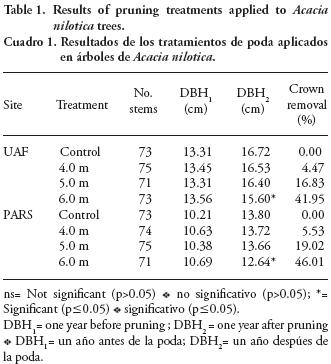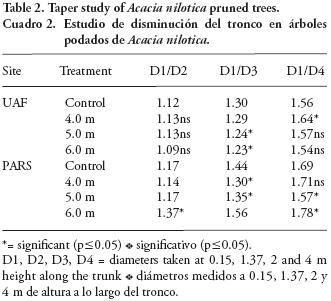Servicios Personalizados
Revista
Articulo
Indicadores
-
 Citado por SciELO
Citado por SciELO -
 Accesos
Accesos
Links relacionados
-
 Similares en
SciELO
Similares en
SciELO
Compartir
Agrociencia
versión On-line ISSN 2521-9766versión impresa ISSN 1405-3195
Agrociencia vol.44 no.1 Texcoco ene./feb. 2010
Recursos naturales renovables
Effect of different pruning intensities on the growth of Acacia nilotica (Kikar)
Efectos de distintas intensidades de poda en el crecimiento de Acacia nilotica (Kikar)
Tahir Siddiqui1, Muhammad Fattakh Nawaz2 *, Irfan Ahmed3
1 Department of Forestry, University of Agriculture Faisalabad, Pakistan.
2 INRA–UR de Géochimie des Sols et des Eaux, Europôle Méditerranéen de l'Arbois, 13545 Aix en Provence Cedex 04, France. *Author for correspondence: (muhammad–farrakh.nawaz@aix.inra.fr).
3 Sub Campus Depalpur, University of Agriculture Faisalabad, Pakistan.
Received: September, 2008.
Approved: August, 2009.
Abstract
In many species, natural pruning is never a satisfactory option if production of clear wood is a management objective. Acacia nilotica is well adapted specie to the arid and semiarid climate of Pakistan and plays an important role in rural economy of the country. Traditional pruning is carried out to maximize the amount of clear–wood production but the effect of this practice on tree growth, still unknown. So a preliminary pruning trial was conducted at two different sites, UAF and PARS, in Faisalabad– Pakistan. All pruning treatments resulted in reduction in diameter growth. However, significant reduction in diameter growth was observed when crown removal was more than 40 %. A taper study was done by taking diameter measurements at different heights. The results revealed that pruning treatments have a significant effect on tapering of the stem. In general, there was a diameter decrease of 1 cm on every 1 m in height.
Key words: Acacia nilotica, diameter growth, stem taper, Pakistan.
Resumen
En muchas especies la poda natural nunca es una opción satisfactoria si se busca la producción de madera libre de nudos. Acacia nilotica es una especie bien adaptada al clima árido y semiárido de Pakistán, y tiene una función importante en la economía rural del país. La poda tradicional se realiza para maximizar la cantidad de madera libre de nudos, pero todavía se desconoce el efecto de esta práctica en el crecimiento del árbol. Por ello, se llevó a cabo una prueba preliminar de podas en dos sitios distintos, UAF y PARS, en Faisalabad, Pakistán. Todos los tratamientos de poda produjeron una reducción en el crecimiento del diámetro. Sin embargo, se observó una reducción significativa en el crecimiento del diámetro cuando se retiró más del 40 % de la copa. Se hizo un estudio de disminución, tomando medidas del diámetro a distintas alturas. Los resultados revelaron que los tratamientos de poda tienen un efecto significativo en la disminución gradual del tronco. En general, hubo una reducción en el diámetro de 1 cm cada 1 m de altura.
Palabras clave: Acacia nilotica, crecimiento del diámetro, disminución gradual del tronco, Pakistán.
INTRODUCTION
Pruning has been a silvicultural technique commonly used to obtain high quality timber. International grading rules establish strict standards for classifying high–quality timber, which include the appearance of knots (number, frequency, diameter, sound or unsound). Yield and market prices decrease considerably for trees without pruning interventions, since lumber must be almost knot–free in order to obtain a high monetary value.
Kikar (Acacia nilotica Wild.) is a highly versatile tree. It is capable of growing on various types of soils and climates but prefers semi–arid, sub–tropical/ tropical climates which have an annual precipitation of 125–1300 mm. It can withstand a moderate level of salinity. In Pakistan, it is found in Sindh, Punjab, Balochistan and NWFP on farmlands and in block plantations (Siddiqui, 1997). A. nilotica is considered one of the highly demanded hardwood timber species in Pakistan. Almost every part of the tree has some use, it is used in furniture industry as well as for medicinal purposes (Dwivedi, 1993). The important property requirements of end–users in A. nilotica include: straight bole with less taper, reduced flutes and buttresses and wood free of knots. Unsound hollow knots and deep flutes in the logs are the two major factors that affect sawn wood grade. However, no adequate data are available for the timber grown with intensive silvicultural practices including pruning (Bhat, 1998). Singh and Bhatnagar (2003) carried out a pruning study on A. nilotica in India. Other studies include a pruning trial on Acacia mangium in Peninsular Malaysia (Majid and Paudyal, 1992), on Eucalyptus nitens in Australia (Wiseman et al., 2006), Pinus elliottii Englem in Brazil (Schneider et al., 1999) and on teak in Costa Rica (Perez et al., 2003; Viquez and Perez, 2005).
The aim of this research was to study the tree growth performance in terms of DBH increment and tapering of stem as a result of various pruning treatments in Pakistan.
MATERIALS AND METHODS
The proposed research was carried out in two sites: 1) in UAF (the experimental area, Department of Forestry, Range Management and Wildlife, University of Agriculture, Faisalabad); 2) in the Postgraduate Agricultural Research Station (PARS), University of Agriculture, Faisalabad. The sites are located in the same city at a distance of 25 km from each other, at 36° 26' N and 73° 06' E; altitude is 185 m. The area can be described as flat; soils are sandy clay loam to clay loam, with a pH ranging from 7.33 to 8.29 and with average rainfall of 250–500 mm per year. Soil samples were taken from 0–30 cm depth. There is low N and P availability on both sites. A. nilotica trees were planted in the experimental areas at a spacing of 3×3 m giving 1110 trees per ha. The trees were irrigated once a week.
Plots of 20×20 m (0.04 ha) were established, each consisting of 49 trees. The experimental design was a randomized complete block design (RCBD) with three replications each 12 plots were established on each site in this experiment. The treatments included pruning up to 0, 4, 5 and 6 m in the 5–year old plantation. Pruning was done on the inner 25 trees leaving the outermost row of trees as a boundary between plots.
Growth variables monitored over one year after the pruning treatment, were DBH (1.37m), and diameters at 0.15, 2 and 4 m. The monitoring of diameters at different heights was done primarily to assess the tapering of the stem. An analysis of variance was performed with the data and means were compared using. Duncan's test (p≤0.05). The trial started in April 2005 and lasted for one year.
RESULT AND DISCUSSION
Pruning study
In the first site, i.e. UAF, the average height of the trees before pruning was 9.62 m and the average crown length was 6.96 m. All pruning treatments resulted in trunk diameter reduction and growth (Table 1) as compared with the control. However, pruning at 6 m was significantly different (p<0.05) from the rest of the treatments, which was probably due to crown removal at more than 40 %. in Table 1 it is shown that crown removal (calculated as percentage of crown length) above 40 % significantly depressed diameter growth.

In PARS, the average height of trees before pruning was 8.5 m and the average crown length was 6.41 m. It is also evident for this site that the removal of crown above 45 % significantly reduced diameter growth (Table 1).
The análisis of the present results indicate that crown removal above 40 % reduced diameter growth significantly on both sites. In the 5–year–old stand at UAF, pruning beyond 5 m resulted in a marked reduction in diameter. It is also evident from the data that pruning beyond 55 % of tree height may inhibit diameter growth significantly. Results are in accordance with Majid and Paudyal (1992), however, may be different from the observations performed on fast growing trees (Perez et al., 2003).
In the pruning treatments, only one of two treatments was significant at two study sites (UAF and PARS). The results are, in general, are not conclusive to monitor pruning effect. However, pruning at 6 m in the first site did have a significant effect on diameter growth.
Taper study
This study was performed to assess the effects of pruning treatments on stem taper. The assessment was conducted by taking diameters at heights of 0.15 m (D1), 1.37 m (D2), at 2 m (D3) and 4 m (D4). The data expressed in ratios are presented in Table 2. The taper study at the experimental area UAF showed that in general, pruning at 4 and 6 m had a significant effect (p<0.05) on taper (Table 2). Taper study at PARS indicated that pruning at 5 and 6 m had a significant effect (p<0.05) on taper.

The taper study showed that 4 and 6 m pruning treatments had a significant effect (p<0.05) on taper only up to 2 m UAF. In the case of PARS, 5 and 6 m pruning treatments had a significant effect (p<0.05) on taper; up to 2 m and 4 m pruning also had a significant effect on taper up to 4 m. However, as only few treatments had a significant effect on taper, the results cannot be generalized. Thus, it can be stated that pruning at 5 and 6 m had a significant effect on taper towards lower trunk (up to 2 m). In other words, some pruning treatments showed a decrease in taper of the stem.
Results from the present taper study seem to support the findings reported by Dakin (1982), Majid and Paudyal (1992) and Singh and Bhatnagar, (2003). The results obtained need to be substantiated by future research as monitoring of taper study for more than one year might give a clearer picture.
CONCLUSIONS
Pruning of A. nilotka revealed a marked reduction in diameter growth when the crown removal was more than 45 %. Pruning treatments caused a decrease on tapering of the trunk. The importance of implementing intensive pruning regimens was shown.
ACKNOWLEDGMENTS
The authors appreciate the assistance of field staff of Dept. Forestry, University of Agriculture, Faisalabad–Pakistan, to conduct this research. We are also indebted to Prof. Dr. Massod A. A. Qurashi for his valuable suggestions to improve this manuscript.
LITERATURE CITED
Bhat, K. M. 1998. Properties of fast–grown teakwood impact on end–user's requirements. J. Trop. For. Sci. 4: 1–10. [ Links ]
Dakin, A. J. 1982. Pruning trial with Sugi Cryptomeria japónica. N.Z.J. For. Sci. 27:89–100. [ Links ]
Dwivedi, A. P. 1993. Acacia nilotica: a multipurpose tree of dry areas. Arid Forestry Research Institute, Johdpur. Indian Council of Forestry Research and Education, Dehra Dun. 226 p. [ Links ]
Majid, N. M., and B. K. Paudyal. 1992. Pruning trial for acacia mangium willd plantations in Peninsular Malaysia. For. Ecol. Manage. 47: 285–293. [ Links ]
Perez, L. D, E. Viquez, and M. Kanninen. 2003. Preliminary pruning programme for Tectona grandis plantations in Costa Rica. J. Trop. For. Sci. 15: 557–569. [ Links ]
Schneider, P. R, C. A. G. Finger, and J. M. Hoppe. 1999. The effect of pruning intensity on the production of Pinus elliottii Engelm., planted in a poor soil in the state of Rio Drande do Sul. Ciencia Florestal 9: 35–46. [ Links ]
Siddiqui, K. M. 1997. Forestry and Environment. Pakistan Forest Institute Peshawar, 2nd ed. 185 p. [ Links ]
Singh, S. B., and S. Bhatnagar. 2003. Response of Acacia nilotica to silvicultural practices in waterlogged and sodic soils. Indian For. 3: 388–392. [ Links ]
Viquez, E., and D. Perez. 2005. Effect of pruning on tree growth, yield, and wood properties of Tectona grandis plantations in Costa Rica. Silva Fenn. 39: 381–390. [ Links ]
Wiseman, D., P. Smethurst, L. Pinkard, T. Wardlaw, C. Beadle, M. Hall, C. Baillie, and C. Mohammed. 2006. Pruning and fertilizer effects on branch size and decay in two Eucalyptus nitens plantations. For. Ecol. Manage. 225: 123–133. [ Links ]














